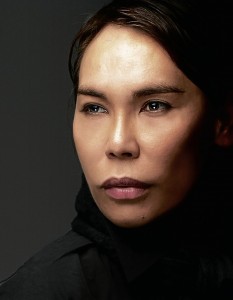
“Very seriously,” he stresses on the phone from Cebu, just days before his gala show.
Santiago is the featured designer in Saturday night’s Red Charity Gala at Makati Shangri-La, an annual, black-tie event project of Kaye Tinga and Tessa Valdes, to benefit the Philippine National Red Cross and the Assumption High School Batch 1981 Foundation. Ariel Lozada will direct.
Cebu’s Santiago, 41, is the third consecutive designer to be featured in the annual Red Charity Gala who traces his training to the Middle East. While this isn’t intentional, Tinga says she and her co-organizers felt inviting Santiago to show this year is fitting, as it was he who first drew attention to the caliber of Middle East-based Filipino designers when he came home and presented a collection here for the first time seven years ago.
Comparison
The Red invite was a challenge, he says, already anticipating the inevitable comparison with One and Cinco, who showed in 2010 and 2011, respectively. One and Cinco are based in Dubai.
“I don’t know how people will receive my collection, but I’m very happy with it,” says Santiago. “It’s my best collection yet. I’m confident. I think this will show that I’m on the same level [as One and Cinco].”
Santiago derives inspiration from origami for his 35-piece collection, a palette of black-and-whites, solid blacks and whites, as well as jewel tones. They’re a mix of short and long dresses, and pants.
It’s “very Cary,” he says of his collection, referring to the intricacy of details—originally tromp l’oeil patterns that assumed three-dimension quality through quilting and metalwork. He attempted to paint on fabric, but decided on origami to play off his strengths. “I wanted to create something like Rorschach patterns, but in origami,” he says.
His signature doily-like laser-cutting will not figure in this collection. “No more of that,” he says, as if to underscore that he has other tricks up his sleeve.
“Since I’m into evening wear, and they’re meant to last a long time, my designs aren’t trendy. That’s why I don’t refer to fashion magazines, but to art books, even furniture, for inspiration,” he says.
“We felt it would be good to see how Cary has evolved,” says Tinga. “Remember that it was he who made us first take notice of the Middle East Filipino designers. When he came home, everyone started talking. And I think you could say, it kept the local designers on their toes. Everybody’s work improved. Cary’s workmanship is extraordinary; his clothes are so beautifully well-made.”
Grand prize
Santiago was on vacation here in 2004 from his job in a couture house in Beirut when he was talked into competing in a design tilt. He won the grand prize, besting fellow Cebuano Jun Escario. By this time, Santiago has also worked in Dubai for several years.
Seven years ago, on another visit, his clients from way back went to him for clothes, after one fashion show. With his career here getting lucrative, he never returned to the Middle East.
“Financially, it’s fulfilling there,” he says. “But artistically, I want it here. Coming home was my fulfillment as a designer. I got good training there in couture, but I’m not into beading. I’m more into fabric manipulations. The women there wouldn’t wear the clothes I wanted to make. I’m into this new kind of opulence, just like Lanvin, or the old masters Balenciaga or Gianfranco Ferre. I’m inspired by them. It’s not like the exaggerated way Lacroix did, or what Galliano did for Dior. Here, I can do a variety of things.”
Unlike One or Cinco, who had access to the finest fabrics when they did their Red collections, Santiago will use only local materials. He doesn’t see this as a setback.
“I was a showgirl from the beginning!” he says emphatically. “I did shows for the couture house in Beirut every season. I know how it’s done, I know what people expect.”